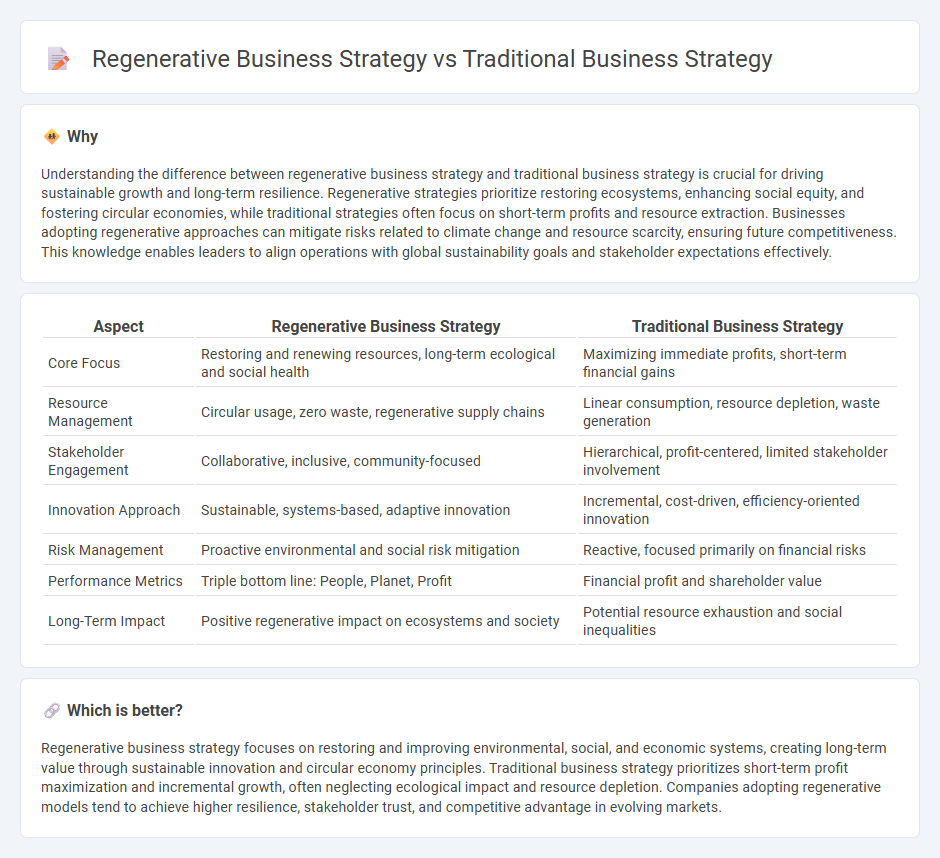
Regenerative business strategy focuses on creating systems that restore and enhance environmental and social well-being, aiming for long-term sustainability and resilience beyond mere profit. Traditional business strategy primarily targets maximizing shareholder value through linear models of production and consumption, often neglecting ecological and social impacts. Explore how integrating regenerative approaches transforms business outcomes and stakeholder value.
Why it is important
Understanding the difference between regenerative business strategy and traditional business strategy is crucial for driving sustainable growth and long-term resilience. Regenerative strategies prioritize restoring ecosystems, enhancing social equity, and fostering circular economies, while traditional strategies often focus on short-term profits and resource extraction. Businesses adopting regenerative approaches can mitigate risks related to climate change and resource scarcity, ensuring future competitiveness. This knowledge enables leaders to align operations with global sustainability goals and stakeholder expectations effectively.
Comparison Table
| Aspect | Regenerative Business Strategy | Traditional Business Strategy |
|---|---|---|
| Core Focus | Restoring and renewing resources, long-term ecological and social health | Maximizing immediate profits, short-term financial gains |
| Resource Management | Circular usage, zero waste, regenerative supply chains | Linear consumption, resource depletion, waste generation |
| Stakeholder Engagement | Collaborative, inclusive, community-focused | Hierarchical, profit-centered, limited stakeholder involvement |
| Innovation Approach | Sustainable, systems-based, adaptive innovation | Incremental, cost-driven, efficiency-oriented innovation |
| Risk Management | Proactive environmental and social risk mitigation | Reactive, focused primarily on financial risks |
| Performance Metrics | Triple bottom line: People, Planet, Profit | Financial profit and shareholder value |
| Long-Term Impact | Positive regenerative impact on ecosystems and society | Potential resource exhaustion and social inequalities |
Which is better?
Regenerative business strategy focuses on restoring and improving environmental, social, and economic systems, creating long-term value through sustainable innovation and circular economy principles. Traditional business strategy prioritizes short-term profit maximization and incremental growth, often neglecting ecological impact and resource depletion. Companies adopting regenerative models tend to achieve higher resilience, stakeholder trust, and competitive advantage in evolving markets.
Connection
Regenerative business strategy and traditional business strategy intersect through their shared goal of long-term value creation, but regenerative approaches emphasize restoring and enhancing natural and social systems alongside economic growth. Traditional strategies often focus on maximizing profit and efficiency within existing market frameworks, while regenerative business integrates sustainability principles, aiming to create resilient ecosystems that benefit both businesses and communities. By combining traditional financial metrics with regenerative impact indicators, companies can drive innovation and competitive advantage grounded in ethical and environmental stewardship.
Key Terms
Competitive Advantage
Traditional business strategy centers on competitive advantage by maximizing shareholder value and outperforming rivals through cost leadership, differentiation, or niche market focus. Regenerative business strategy prioritizes creating resilient ecosystems and stakeholder value, fostering long-term sustainability and innovation beyond mere competition. Explore how regenerative approaches redefine success metrics and drive systemic impact in modern enterprises.
Systems Thinking
Traditional business strategy emphasizes linear processes and short-term financial gains, often neglecting environmental and social impacts. Regenerative business strategy integrates systems thinking by promoting circular economies, resource renewal, and stakeholder collaboration to create long-term value and resilience. Explore how adopting regenerative models can transform business sustainability and innovation.
Stakeholder Value
Traditional business strategy emphasizes maximizing shareholder value often prioritizing short-term financial gains over broader social and environmental concerns. Regenerative business strategy centers on creating long-term stakeholder value by integrating ecological health, social equity, and economic prosperity into core operations. Explore how shifting to regenerative approaches can enhance holistic stakeholder value and ensure sustainable business success.
Source and External Links
What Is A Traditional Business Model? - A Comprehensive ... - A traditional business strategy centers on established methods such as physical storefronts, direct sales, and print advertising, focusing on stability, hierarchy, and delivering tangible products or services through conventional channels with clear value propositions and structured cost and revenue models.
Business Design vs. Traditional Strategy - INNOBASE - Traditional business strategy is built on structured analysis, long-term forecasting, and optimizing operational efficiency for stable markets, but tends to be rigid and less adaptable in today's fast-changing environments.
The traditional strategy process - strategy making in the past - Traditional strategy making begins with a company's vision and mission, follows with internal and external analyses (such as SWOT), selects from strategic options, and assumes a stable and predictable environment for long-term planning.
 dowidth.com
dowidth.com